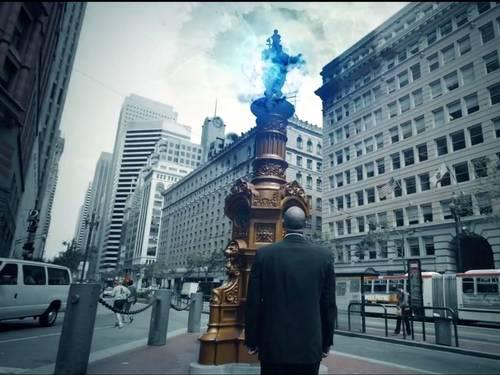

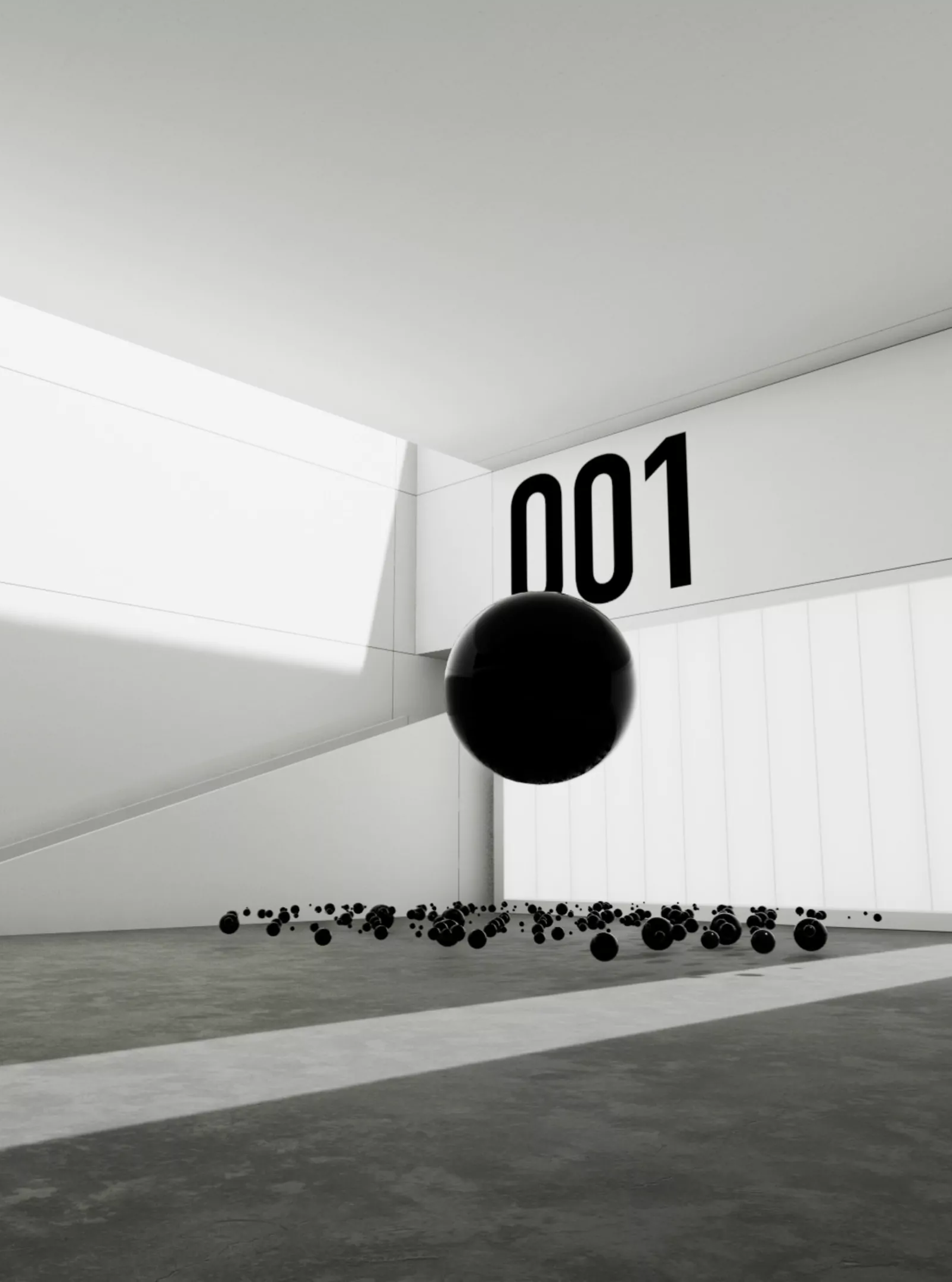
Maxim Zhestkov
Modules
Modules is a VR art experience, where architecture, sculpture, film, and music blend together to immerse viewers into Zhestkov’s world. A total work of art, it is a world that questions the established definitions of our reality. In digital space, we can abandon the logic of reality and are freed from its boundaries. New worlds with total freedom are possible, worlds only limited by our creativity and the potential of art.
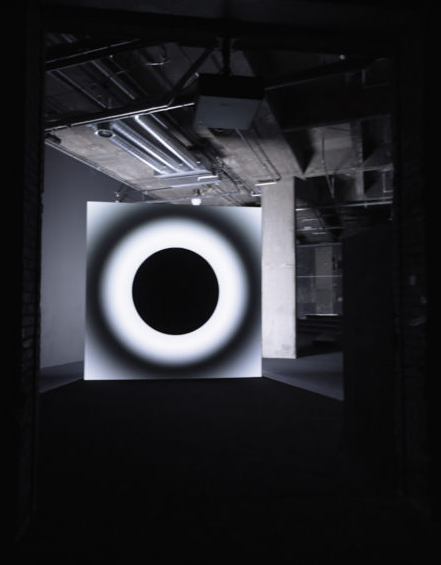
Ryoji Ikeda
point of no return
With point of no return, Ryoji Ikeda condenses the unknowable chaos of the event horizon of a black hole into a work of order and balance. Composing a delicate assemblage of basic shapes, sounds, light and shadow, the artist eschews the intricacies of data for a more sculptural approach. While gesturing towards the sublime, the infinite expanse of space and the immense, reality-warping gravitational force of a black hole, he focuses in on the beauty of the physical, bringing together a few simple elements to make sense of something unthinkably complex. Through his own artistic process of playing with space, the artist finds purity in basic structures while drawing inspiration from the vast scope of the universal. “point of no return is a very simple, very intense piece,” he says.

QUBIT AI – International Electronic Language Festival – Art and Technology
QUBIT AI | quantum & synthetic ai
Electronic Language International Festival
July 3rd to August 25th
Tuesday to Sunday, 10am – 8pm
FIESP Cultural Center
Design: André Lenz
Image: Iskarioto Dystopian AI Films – Athena
QUBIT AI
In its 25 years of existence, the International Electronic Language Festival (FILE) is an internationally renowned Brazilian project that since 2000 has explored the intersection between art and technology. With more than two decades of history, the festival stands out for fostering exhibition spaces and debate about artistic innovations driven by disruptive and innovative technologies, inviting the public to get involved with experimental forms of art that challenge the boundaries of conventionality. Currently, two of these technologies stand out in the contemporary scenario: the accelerated development of quantum computing and artificial intelligence corroborated by synthetic data.
Quantum computing, an emerging revolution in the technological field, offers a new range of creative possibilities for contemporary artists. This new era allows the exploration of unprecedented frontiers through a new computational format that consists mainly of quantum superposition and entanglement, a new field of exploration for synthetic computer science, as well as for the arts in general; on the other hand, artificial intelligence, fueled by synthetic data, offers artists a new way of making and understanding art, opening up space for new forms, concepts and artistic expressions.
Entitled QUBIT AI, the exhibition delves into this unexplored territory presenting a selection of works of art resulting from the connection between artistic creation and technology, proposing a theoretical reflection on what the interrelationship between quantum computers and synthetic artificial intelligence will be.
Visitors will be invited to experience immersive installations, experimental videos, digital sculptures and other forms of interactive art, which intertwine reality and imagination. The exhibition encourages reflections on the influence of technology on art and contemporary society, while at the same time providing an environment to compare already established technological arts (analog and digital) with the possible futures of art in the synthetic era, enhanced by quantum computing. The QUBIT AI exhibition at FILE SP 2024 transcends the mere presentation of works of art; it is a journey to the limits of human creativity, driven by the convergence of art, science and technology.
Ricardo Barreto and Paula Perissinotto
co-organizers and curators of FILE
International Electronic Language Festival

QUBIT AI: Camila Magrane
The Witness
FILE 2024 | Installations
International Electronic Language Festival
Image activated by augmented reality, where 3D animated subjects and scenarios are integrated into a physical photograph. Inspired by the work of Carl Jung, the image is part of a larger series that explores themes such as identity, introspection and transformation. Through AR, game elements were introduced into the piece, offering virtual content unlockable through interactions.
Bio
Camila Magrane is a Venezuelan-American visual artist known for her augmented reality images, integrating 3D animated scenes and subjects into physical photographs. With experience in video game development and a passion for analog photography, she explores the dialogue between the virtual and physical worlds. Magrane’s images are inspired by surrealist compositions and reference the graphic hyperrealism of contemporary video game design.

QUBIT AI: Banz & Bowinkel
Bots
FILE 2024 | Installations
International Electronic Language Festival
Bots presents a computer-controlled society through a series of algorithmically controlled humanoid avatars that appear on physical carpets using augmented reality (AR). Real-time performances synthesize human behavioral patterns into a formalized digital social study. Omnipresent, combined with our devices and incorporated into virtual environments, the work reminds us of our own digitalized world, in which we are surrounded by invisible bots.
Bio
Giulia Bowinkel (born 1983) and Friedemann Banz (born 1980) live in Berlin and have worked together under the name Banz & Bowinkel since 2009. In 2007 they graduated from the Art Academy with Albert Oehlen and started making art with computers . His work encompasses computer-generated imagery, animation, augmented reality, virtual realities and installations.
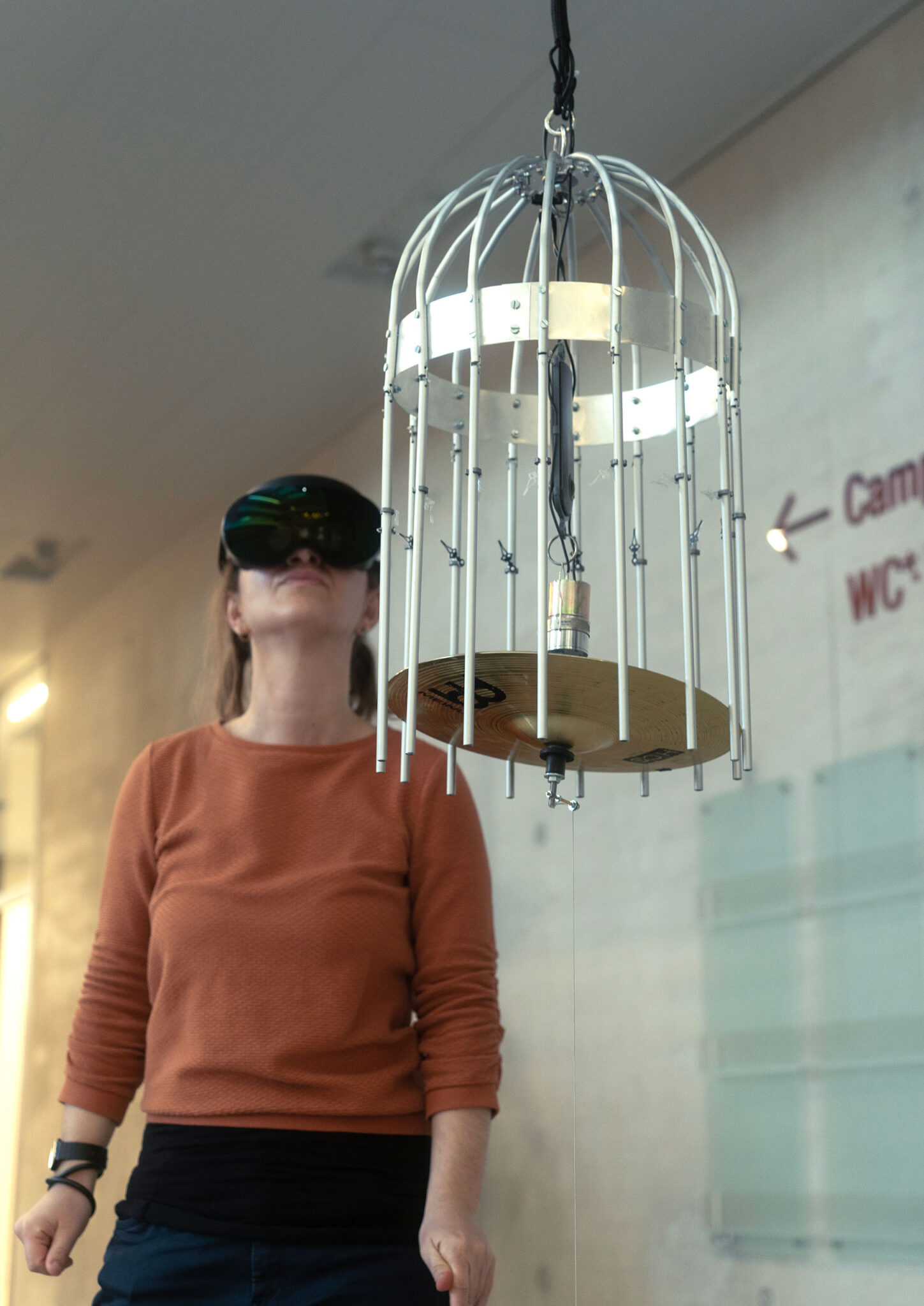
QUBIT AI: Anna Vasof & VRinMotion Team
The Cage of Time
FILE 2024 | Installations
International Electronic Language Festival
Interactive installation that presents a kinetic instrument object and virtual reality glasses, functioning as a device that animates the illusion of the passage of time in virtual space. In the fabric of existence, time weaves a cage around our ephemeral moments, limiting our perceptions of the past, present and future. By embracing this paradox, we may discover that the cage of time becomes the crucible where the alchemy of experience transforms our understanding of existence.
Bio
Anna Vasof is a multi-award-winning artist who focuses on filmmaking, short videos, and time-based sculptures. VRinMotion is an artistic research project based at St. Pölten University of Applied Sciences in Austria that investigates how features of stop-motion animation and motion capture can be combined with virtual reality to enrich current artistic discourse.
Credits
VRinMotion Team: Franziska Bruckner, Christoph Schmid, Clemens Gürtler, Matthias Husinsky, Christian Munk, Julian Salhofer, Stefan Nebel, Vrääth Öhner.
Concept by: Anna Vasof.
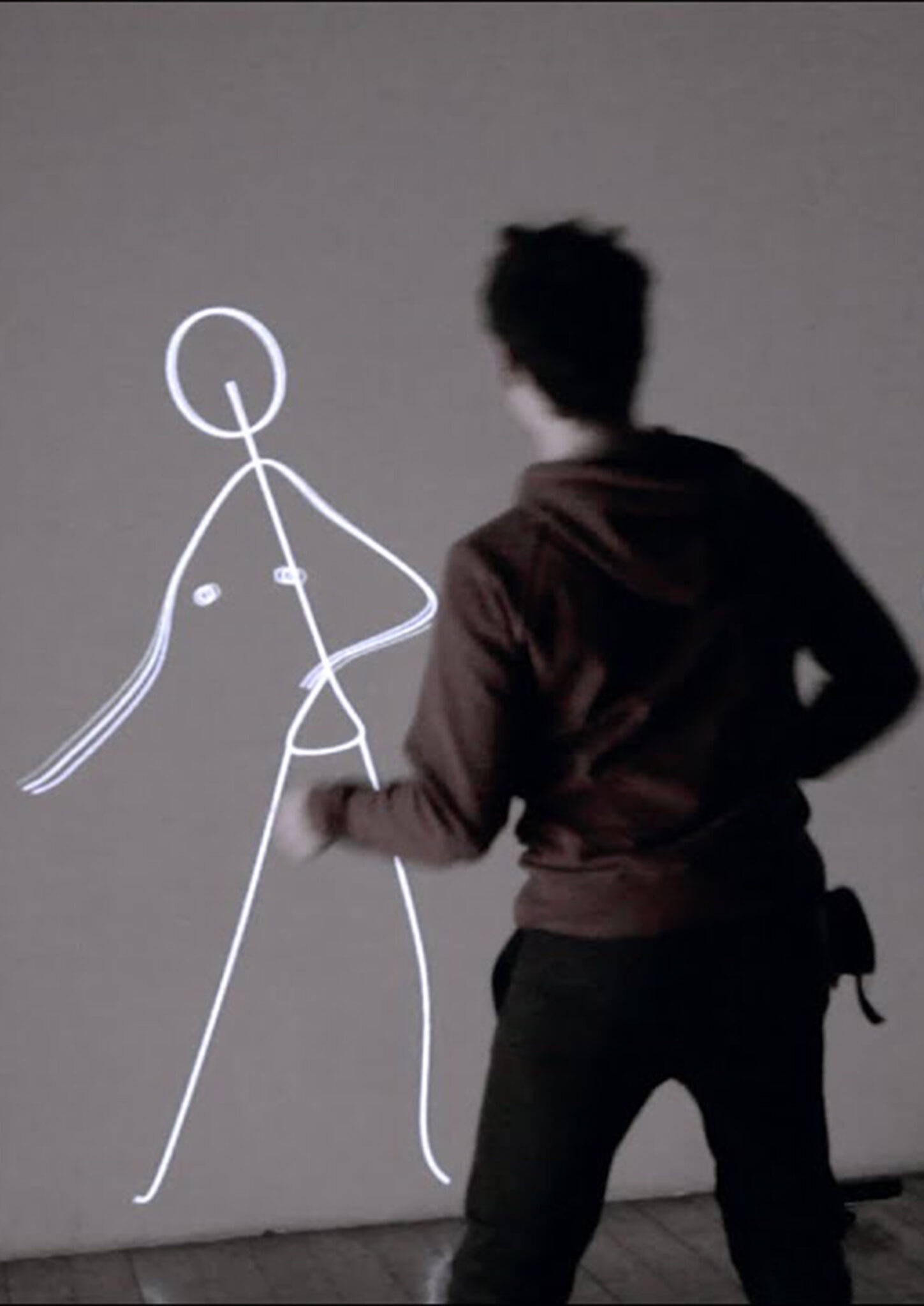
QUBIT AI: Klaus Obermaier, Stefano D’Alessio & Martina Menegon
EGO
FILE 2024 | Installations
International Electronic Language Festival
The mirror stage in psychology explains how the Ego forms through objectification, where one’s visual appearance comes into conflict with emotional experience, a concept called ‘alienation‘ by psychoanalyst Jacques Lacan. The interactive installation EGO reenacts and reverses this process by distorting the mirror image based on the user’s movements, highlighting the tension between the real and the symbolic, the Ego and the It, subject and object.
Bio
Klaus Obermaier is an interdisciplinary artist, director and composer who creates innovative works in the performing arts, music and installations using new media. Stefano D’Alessio researches social issues induced by the internet and explores how the web and its derivatives influence human behavior and the body. Martina Menegon creates intricate assemblages of physical and virtual elements, exploring the contemporary self and its hybrid corporeality.
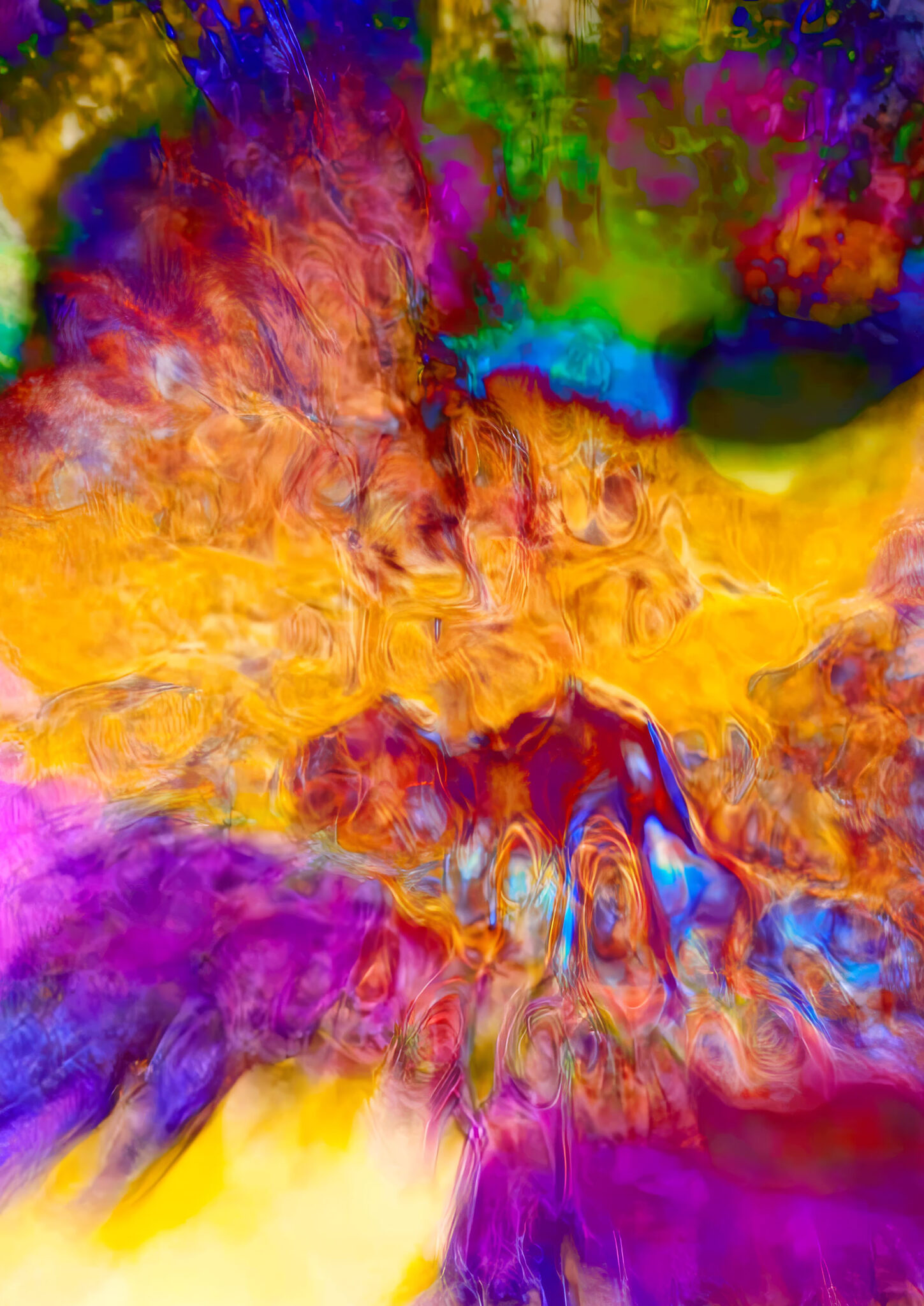
QUBIT AI: Michael Sadowski (aka derealizer)
Stealth Technology of Ancient, Cosmic Pantheons
FILE 2024 | Aesthetic Synthetics
International Electronic Language Festival
Michael Sadowski (aka derealizer) – Stealth Technology of Ancient, Cosmic Pantheons – Austria
An abstract painting in motion, with colors and shapes exploding and transforming to the rhythm of the music. The dynamic element is not trapped in a static image, but can unfold in time and space.
Bio
Using Stable Diffusion, a visual synthesizer, the artist turns fantasies into videos using just a PC, similar to the invention of printing 600 years ago. Exploring the interplay between software algorithms that create visual worlds and the artist’s mind guiding this process is incredibly exciting. Unlike traditional cinema, there is no ‘reality’ or humans involved, making it a satisfying medium for creating visual art.
Credits
Visuals: Michael Sadowski
Music: Stealth Technology of Ancient, Cosmic Pantheons by The Intangible
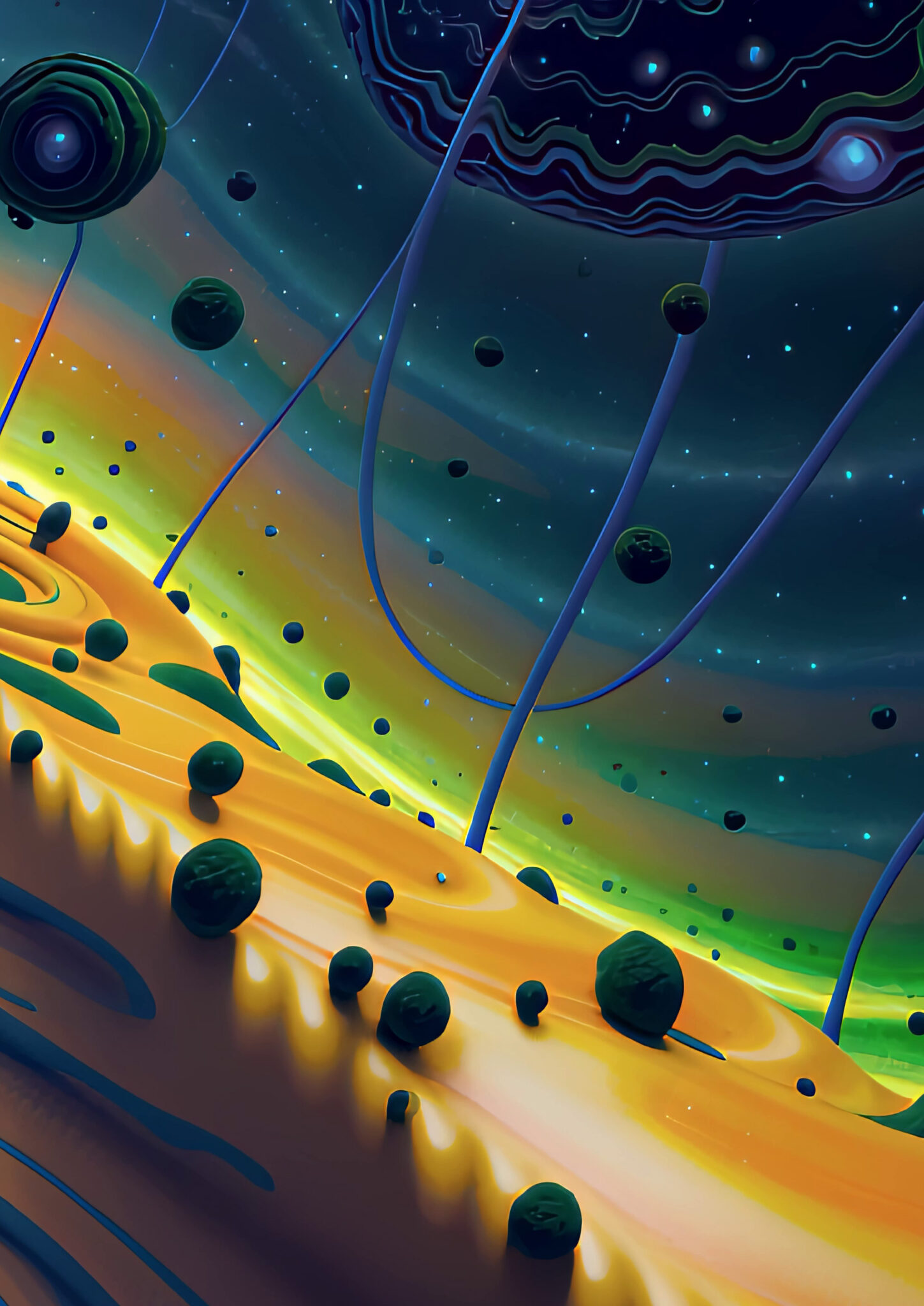
QUBIT AI: Michael Sadowski (aka derealizer)
Distortions of The Past
FILE 2024 | Aesthetic Synthetics
International Electronic Language Festival
Michael Sadowski (aka derealizer) – Distortions of The Past – Austria
Fractal elements that resemble cosmic structures evoke the illusion of traveling through a fractal universe. Rules, in the form of prompts, and chance interact with each other to create a visual fantasy.
Bio
Using Stable Diffusion, a visual synthesizer, the artist turns fantasies into videos using just a PC, similar to the invention of printing 600 years ago. Exploring the interplay between software algorithms that create visual worlds and the artist’s mind guiding this process is incredibly exciting. Unlike traditional cinema, there is no ‘reality’ or humans involved, making it a satisfying medium for creating visual art.
Credits
Visuals: Michael Sadowski
Music: Distortions of the Past by Dreamstate Logic

QUBIT AI: Kelly Luck
Kelly Luck
Strangeland 1 (excerpt)
FILE 2024 | Aesthetic Synthetics
International Electronic Language Festival
Kelly Luck – Strangeland 1 (excerpt) – United States
From a surrealist point of view, the main attraction of generative AI, for the artist, is its lack of memory. At any given moment, she only has the current frame and instructions on how to proceed, similar to free association in dreams. This work is part of a series of long-term environments designed to immerse the viewer in a constantly evolving and never-ending landscape, inviting relaxation and engagement.
Bio
As part of the first generation to grow up around computers, Kelly Luck quickly became fascinated with the creative possibilities of this new technology. Her journey has ranged from pixel art and graphic ‘hacks’ to the 90s demoscene, 2D and later 3D graphics, and now the modern tools of digital art. With the emergence of generative AI, it endlessly explores how technology continues to blur the line between imagination and reality.

QUBIT AI: AESTHETIC SYNTHETIC FILE – São Paulo 2024 – Art and Technology
FILE 2024
QUBIT AI | quantum & synthetic ai
Electronic Language International Festival
July 3rd to August 25th
Tuesday to Sunday, 10am – 8pm
FIESP Cultural Center
Design: André Lenz
Image: Iskarioto Dystopian AI Films – Athena
QUBIT AI
In its 25 years of existence, the International Electronic Language Festival (FILE) is an internationally renowned Brazilian project that since 2000 has explored the intersection between art and technology. With more than two decades of history, the festival stands out for fostering exhibition spaces and debate about artistic innovations driven by disruptive and innovative technologies, inviting the public to get involved with experimental forms of art that challenge the boundaries of conventionality. Currently, two of these technologies stand out in the contemporary scenario: the accelerated development of quantum computing and artificial intelligence corroborated by synthetic data.
Quantum computing, an emerging revolution in the technological field, offers a new range of creative possibilities for contemporary artists. This new era allows the exploration of unprecedented frontiers through a new computational format that consists mainly of quantum superposition and entanglement, a new field of exploration for synthetic computer science, as well as for the arts in general; on the other hand, artificial intelligence, fueled by synthetic data, offers artists a new way of making and understanding art, opening up space for new forms, concepts and artistic expressions.
Entitled QUBIT AI, the exhibition delves into this unexplored territory presenting a selection of works of art resulting from the connection between artistic creation and technology, proposing a theoretical reflection on what the interrelationship between quantum computers and synthetic artificial intelligence will be.
Visitors will be invited to experience immersive installations, experimental videos, digital sculptures and other forms of interactive art, which intertwine reality and imagination. The exhibition encourages reflections on the influence of technology on art and contemporary society, while at the same time providing an environment to compare already established technological arts (analog and digital) with the possible futures of art in the synthetic era, enhanced by quantum computing. The QUBIT AI exhibition at FILE SP 2024 transcends the mere presentation of works of art; it is a journey to the limits of human creativity, driven by the convergence of art, science and technology.
Ricardo Barreto and Paula Perissinotto
co-organizers and curators of FILE
International Electronic Language Festival

QUBIT AI: Michael Sadowski (aka derealizer)
Magic Drops
FILE 2024 | Interator – Sound Synthetics
International Electronic Language Festival
Michael Sadowski (aka derealizer) – Magic Drops – Austria
Moving abstract structures and grimacing masks, colors that change and pulse to the rhythm of the music create a psychedelic experience that embodies the spirit of Techno.
Bio
Using Stable Diffusion, a visual synthesizer, the artist turns fantasies into videos using just a PC, similar to the invention of printing 600 years ago. Exploring the interplay between software algorithms that create visual worlds and the artist’s mind guiding this process is incredibly exciting. Unlike traditional cinema, there is no ‘reality’ or humans involved, making it a satisfying medium for creating visual art.
Credits
Music: Chris Robert

QUBIT AI: Michael Sadowski (aka derealizer)
In Love
FILE 2024 | Interator – Sound Synthetics
International Electronic Language Festival
Michael Sadowski (aka derealizer) – In Love – Austria
Fractal structures move to the sound of progressive house as the virtual camera navigates through this fractal world. To intensify the psychedelic quality, a second layer contrasts with the movement, resulting in a joyful madness of colors.
Bio
Using Stable Diffusion, a visual synthesizer, the artist turns fantasies into videos using just a PC, similar to the invention of printing 600 years ago. Exploring the interplay between software algorithms that create visual worlds and the artist’s mind guiding this process is incredibly exciting. Unlike traditional cinema, there is no ‘reality’ or humans involved, making it a satisfying medium for creating visual art.
Credits
Music: Y do I

QUBIT AI: Luigi Novellino (aka PintoCreation)
Blob Alien Mouth
FILE 2024 | Interator – Sound Synthetics
International Electronic Language Festival
Luigi Novellino (aka PintoCreation) – Blob Alien Mouth – Italy
The journey begins with Deforum, using the Automatic1111 interface to create basic images with the StableDiffusion XL, EndjourneyXL, and Lora XLFullArt templates. The video undergoes a transformation using the Absolute Reality model and Lora Aurora style, guided by the IPAdapter node and refined by QrCode Controlnet.
Bio
Fascinated by the limitless domain of AI, Luigi Novellino adopts the title syntographer, a term that resonates deeply within the community. The artist often asks himself: “am I an artist?” Art, in his view, defies rigid definitions or limits; it represents a fluid expression of creativity that transcends labels. The artist’s ultimate goal is to awaken something in the viewer, provoking thoughts and evoking emotions.
Credits
Music: Oleh Boretskyi

QUBIT AI: FILE QUANTUM WORKSHOP 2024 – São Paulo – Art and Technology
FILE 2024
QUBIT AI | quantum & synthetic ai
Electronic Language International Festival
July 3rd to August 25th
Tuesday to Sunday, 10am – 8pm
FIESP Cultural Center
Design: André Lenz
Image: Iskarioto Dystopian AI Films – Athena
QUBIT AI
In its 25 years of existence, the International Electronic Language Festival (FILE) is an internationally renowned Brazilian project that since 2000 has explored the intersection between art and technology. With more than two decades of history, the festival stands out for fostering exhibition spaces and debate about artistic innovations driven by disruptive and innovative technologies, inviting the public to get involved with experimental forms of art that challenge the boundaries of conventionality. Currently, two of these technologies stand out in the contemporary scenario: the accelerated development of quantum computing and artificial intelligence corroborated by synthetic data.
Quantum computing, an emerging revolution in the technological field, offers a new range of creative possibilities for contemporary artists. This new era allows the exploration of unprecedented frontiers through a new computational format that consists mainly of quantum superposition and entanglement, a new field of exploration for synthetic computer science, as well as for the arts in general; on the other hand, artificial intelligence, fueled by synthetic data, offers artists a new way of making and understanding art, opening up space for new forms, concepts and artistic expressions.
Entitled QUBIT AI, the exhibition delves into this unexplored territory presenting a selection of works of art resulting from the connection between artistic creation and technology, proposing a theoretical reflection on what the interrelationship between quantum computers and synthetic artificial intelligence will be.
Visitors will be invited to experience immersive installations, experimental videos, digital sculptures and other forms of interactive art, which intertwine reality and imagination. The exhibition encourages reflections on the influence of technology on art and contemporary society, while at the same time providing an environment to compare already established technological arts (analog and digital) with the possible futures of art in the synthetic era, enhanced by quantum computing. The QUBIT AI exhibition at FILE SP 2024 transcends the mere presentation of works of art; it is a journey to the limits of human creativity, driven by the convergence of art, science and technology.
Ricardo Barreto and Paula Perissinotto
co-organizers and curators of FILE
International Electronic Language Festival

QUBIT AI: FILE OPENING LECTURE 2024 – São Paulo – Art and Technology
FILE 2024
QUBIT AI | quantum & synthetic ai
Electronic Language International Festival
July 3rd to August 25th
Tuesday to Sunday, 10am – 8pm
FIESP Cultural Center
Design: André Lenz
Image: Iskarioto Dystopian AI Films – Athena
QUBIT AI
In its 25 years of existence, the International Electronic Language Festival (FILE) is an internationally renowned Brazilian project that since 2000 has explored the intersection between art and technology. With more than two decades of history, the festival stands out for fostering exhibition spaces and debate about artistic innovations driven by disruptive and innovative technologies, inviting the public to get involved with experimental forms of art that challenge the boundaries of conventionality. Currently, two of these technologies stand out in the contemporary scenario: the accelerated development of quantum computing and artificial intelligence corroborated by synthetic data.
Quantum computing, an emerging revolution in the technological field, offers a new range of creative possibilities for contemporary artists. This new era allows the exploration of unprecedented frontiers through a new computational format that consists mainly of quantum superposition and entanglement, a new field of exploration for synthetic computer science, as well as for the arts in general; on the other hand, artificial intelligence, fueled by synthetic data, offers artists a new way of making and understanding art, opening up space for new forms, concepts and artistic expressions.
Entitled QUBIT AI, the exhibition delves into this unexplored territory presenting a selection of works of art resulting from the connection between artistic creation and technology, proposing a theoretical reflection on what the interrelationship between quantum computers and synthetic artificial intelligence will be.
Visitors will be invited to experience immersive installations, experimental videos, digital sculptures and other forms of interactive art, which intertwine reality and imagination. The exhibition encourages reflections on the influence of technology on art and contemporary society, while at the same time providing an environment to compare already established technological arts (analog and digital) with the possible futures of art in the synthetic era, enhanced by quantum computing. The QUBIT AI exhibition at FILE SP 2024 transcends the mere presentation of works of art; it is a journey to the limits of human creativity, driven by the convergence of art, science and technology.
Ricardo Barreto and Paula Perissinotto
co-organizers and curators of FILE
International Electronic Language Festival

Ziyang Wu
Event Modeling
AI Fossil
The work began with the collection and collation of various news and social events that have occurred or are happening based on social media algorithms, and utilized dreamfields3D to generate 3D models using the titles of news/events as the seeding words/sentences. In the era of AI technology blowout (but also in its “baby-like” era), the work records all kinds of human information as “AI fossils” through AI text to 3D model generation technology. In the future “abandoned factory” scene that is mixed with reality and virtual, it is full of different experiences between humans and AI on the same event. Human information is presented as some realistic fragments, some historical fossils, a pile of metal carvings, or a pile of inferior plastic toys.
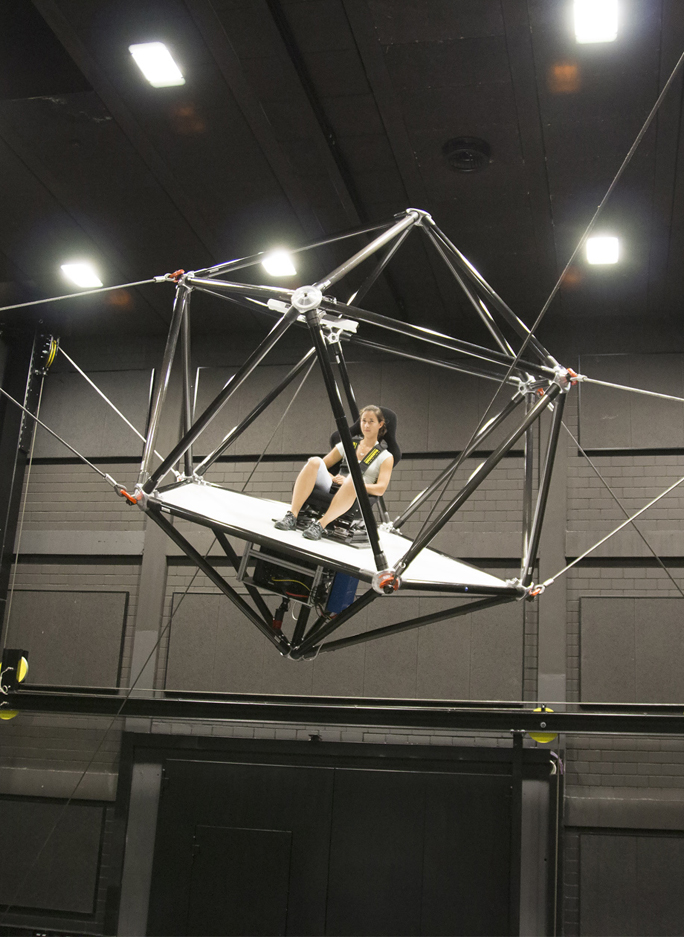
Heinrich Bulthoff
Cable Robot Simulator
Max-Planck-Institut für biologische Kybernetik
Eight steel cables, each with 1.4 tons of tensions, hold aloft a caged platform with a seat for one person. Using a wireless VR headset, that person can simulate experiences like flight while being zoomed in dozens of different ways. Eight retracting cables connected to a winch pull on the cage. It’s like a giant, flying VR jungle gym.
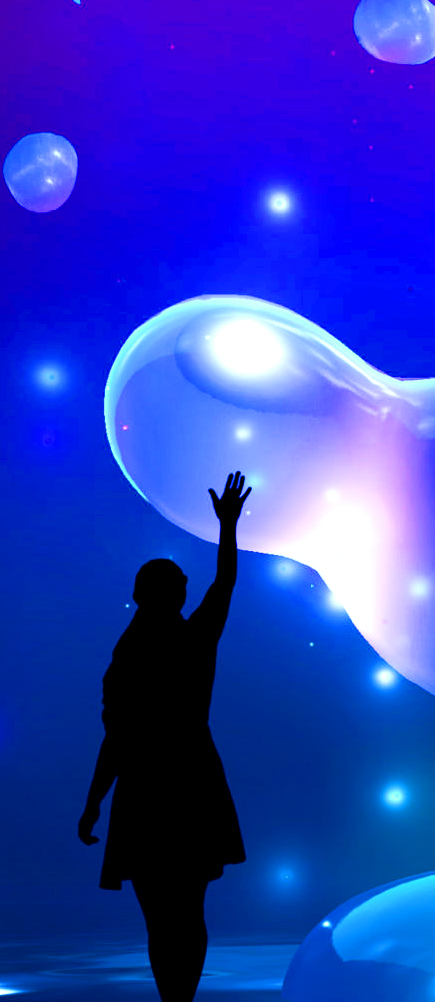
Michaela Pnacekova
A Symphony of Noise
Created by Michaela Pnacekova, Jamie Balliu
Herbert’s everyday sound sources are the inspiration for A Symphony of Noise VR. This interactive virtual reality experience is a journey through four sonic landscapes. The first centers on breathing, which immediately makes you focus on listening to the world differently. This is followed by an arctic environment full of scraping and crunching sounds, and finally a shop interior. Using the controllers or by blowing or singing, you can add sounds to the audio palette, which is visualized as waves and colors in three-dimensional space. In the fourth and final landscape, all the sounds are combined in an ultimate symphony.
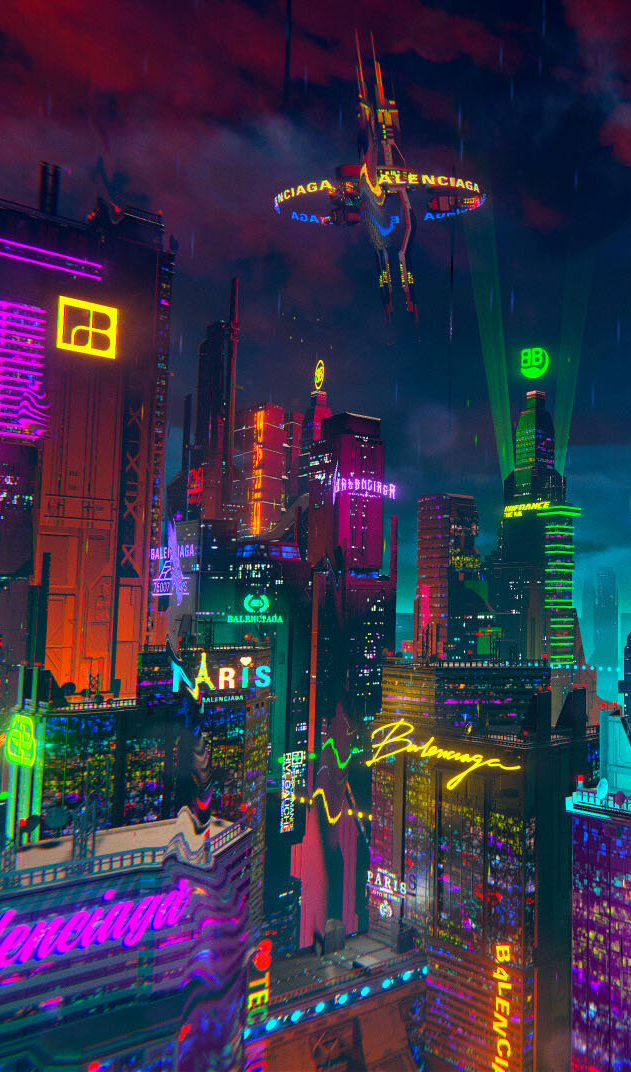
tabor robak
balenciaga collaboration
A 25 minute video loop with previously unreleased tracks by DJ Hell, made in collaboration with Balenciaga.
Here is a dramatic tension in his work between the real and the imagined in his use of often-appropriated digital objects to create virtual landscapes, which frequently contain elements – animals, machines, fragments of videogames – that are recognisable from our day to day life. This creates a symbiotic relationship between the digital and the real. In a very real way digital space has now become an intangible reality. The worlds built by Robak have a distinctly cinematic sensibility that hyperbolises the shine and dramatic effects of 3D rendered animation. The aesthetic of his work is supremely important, drawing the viewer into a truly alluring, indulgent and strangely gratifying environment. There is a further challenge to the void between high-art and the worlds of 3D animation and gaming, in the intersection between depiction and simulation. This can be partially attributed to the vernacular of advertising Robak is so proficient at utilising.

Roman Ermakov
Роман Ермаков
live sculpture
Our perception — the only true reality. Creation as a feeling that generates the image, expressed in the form. Beauty manifesto calling to go beyond that limit imagination. The aesthetics of art can not be reduced to a clear set of building blocks with which you can strengthen or weaken the perception of contrast. Beauty should not be subjected to analysis, that is communication and the call to participate in the transformation of the emotional to the visible.The process of creating — is the alignment of the mosaic, many repetitions of simple and pure elements, which form a collection, harmonious in its incompleteness.

Camille Legrand & Bart Hess
Epistēmē
Titled with the Ancient Greek word for knowledge and understanding, the installation is born of the belief that we absorb knowledge through the senses, with the skin acting as an interface between the body and the world around us. ‘To illustrate the skin in states of transformation, I imagined it as a canvas for sensations felt and information absorbed. The digital manipulation in each film melds body and sensation, skin and material, reality and virtuality to express the effects of each product,’

bohyun yoon
БОХЬЮН ЮН
윤보현
To Reverse Yourself
My work poses the question: how does reality becomes exquisitely animated by certain social control systems such as politics, mass media, technology, science, and etc. It is my artistic goal to reveal how human beings are fragile and delicate in these social environments. By living in Korea, Japan and the U.S, I have first-hand experience in diverse social systems and have come to view my life experiences as raw material for my research. With my research in mind, my art utilizes the body as the tool for an intensive investigation of the public and private; examining the relationship between how people understand their body and how this understanding represents themselves in the greater context.
Currently, I am curious about human perception developing parallel with the ever-evolving progression of technological world. Thus, I question technology’s relationship to reality and illusion; asking what is reality? My work takes advantage of illusion to explore and answer this question, and often my artistic materials consist of the body and mirrors. I use mirrors for integrating reality and illusion.

Nicole Zisman
I frequently entertain the idea that everything we perceive might actually not be real at all, that the world around me could actually just be my senses lying to me. The idea that “reality is a hoax” completely freaks me out, so naturally it became the concrete starting point for my collection. From this, I began to develop different ways of “imagining” garments, of finding ways of putting things that are not really there into existence. I wanted to blur the lines of real versus imagined//artificial. Print was the best facilitator of this goal.
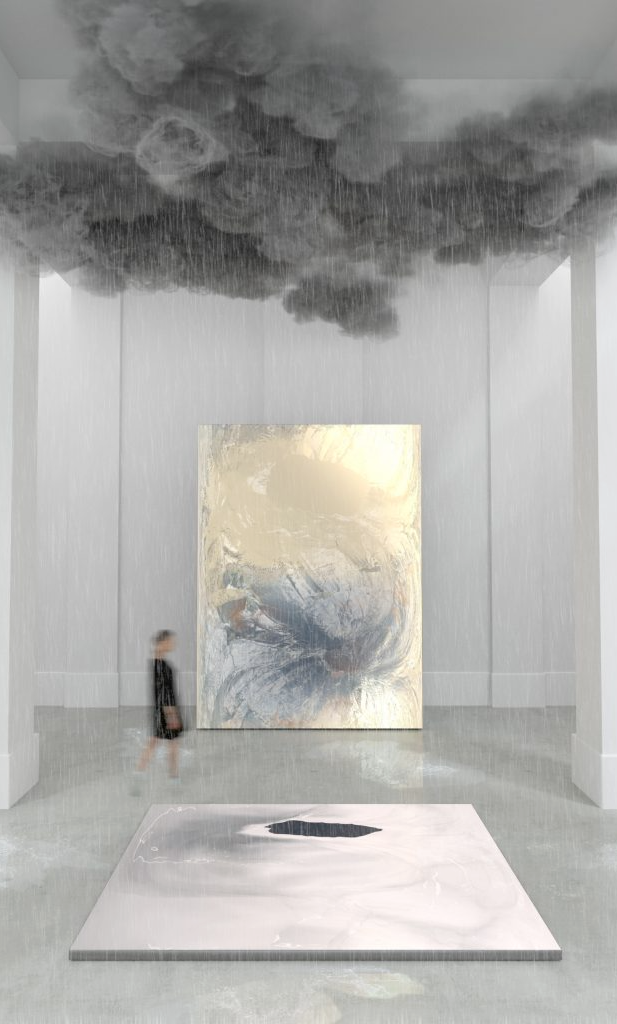
Carla Chan
Falling Black
Unfalling Black is an augmented reality experience that reveals digitally manipulated weather formation in an enclosed environment. Treating the mobile device as a digital window, the work uncovers the displacing choreography of rain, storms and snow, occurring all around the audience and yet witnessed only through the computerized lens.

Stan Douglas
Doppelgänger
When one spacecraft embarks on its journey, another is launched at the same time in a parallel reality. Alice, a solitary astronaut, is teleported to a distant planet, and so is her double. When Alice and her ship return, she assumes her mission has failed and she has somehow returned home; but she has, in fact, arrived at a world where everything is the reverse of what she once knew. Doppelgänger presents a nuanced and layered parable that powerfully addresses the slippery notion of objective truth, and the position of the ‘other’ in contemporary society.

Brodbeck & de Barbuat
Les 1000 vies d’Isis
Les 1000 vies d’Isis (The 1000 lives of Isis) highlights the birth of an imaginary character created entirely by computer. A virtual identity whose daily life is imagined in images. The fictitious staging of these moments photographed in the South of France interrogates Photography and Portraiture by introducing a questioning on the nature of images, their link to reality and to the identity of the living.

Leo Scarin
Variations on a Remote Room
Variations on a remote room is a series of digitized living spaces belonging to remote friends and loved ones who could not meet physically for a year. The work is composed by a number of photogrammetries made in remote collaboration and placed into a Virtual Reality environment where they can re-inhabit, intimately, their domestic spaces.

Alexandr Grigorev
Scraps n19
This virtual sculpture impossible to create in physical world but still looks really real. It’s an example of post-reality that widely used in my practice.

Meiro Koizumi
Prometheus Bound
In Greek Mythology, Prometheus stole fire (technology) from Zeus and gave it to humans, and for this, he got crucified on a mountaintop, and had to endure the eternal pain as a punishment. Since the beginning of our civilization, technology has been the source of prosperity and development. But also it has been the cause of great tragedies such as war sand nuclear accidents. Setting the Aeschylus Greek tragedy “Prometheus Bound” as a starting point, Koizumi created VR (Virtual Reality) theater which deals with this age-old tension between humanity and technology, through collaboration with a person who is desperately longing for the technological advancement – a person who is suffering from ALS (Amyotrophic Lateral Sclerosis- the deadly neurological disease that make a person paralyzed). Through the dialogues with the man about his personal life and his visions of the future, they created a sci-fi vision in which past and future, self and others, humans and machines are all merged into one sequence of abstract VR theatrical experience.

JF Malouin
Les trois Grâces
file festival
“Les Trois Grâces” is a presence and corporeality simulation in virtual reality. Exposing the underlying power struggle implied within touch, this piece explores the trespassing of bodily frontiers and territoriality. As a sculpture, its object is not matter, but our relationship to the other.
It offers a troubling experience of intimate proportions.

INES ALPHA
Ines Alpha likes blurring the frontiers between reality and fiction. And by being a 3D makeup artist she makes reality more fantastic and surreal.
.
Ines Alpha 喜欢模糊现实与虚构之间的界限。作为一名 3D 化妆师,她让现实变得更加梦幻和超现实。
.
Ines Alpha는 현실과 허구의 경계를 모호하게 만드는 것을 좋아합니다. 그리고 그녀는 3D 메이크업 아티스트가 됨으로써 현실을 더욱 환상적이고 초현실적으로 만듭니다.

Penique Productions
Park Lage
In the installation, an 11m x 15m x 25m orange inflatable that completely covered the historic courtyard, the viewer accesses the interior of the work and observes how the previously known space, or not, was reconfigured by a monochromatic plastic cover, through which only the shapes of a reality that has just become a work are drawn. This work makes visible a space that was previously just the place where things live. A work that the wind, the sun, the rain and the passing of people keeps alive, breathing.

Gonzalo Cueto
Kit Básico
FILE FESTIVAL
The strategy is basically to oppose the residual imaginary, a series of light signals, wherein the video plays at being a future that reality look, using sunlight and smoke signals as a flexible margin of the latter where we will be in. There is a performance based on first calculating an escape, rejecting to be installed in the final place in our economic diaspora.
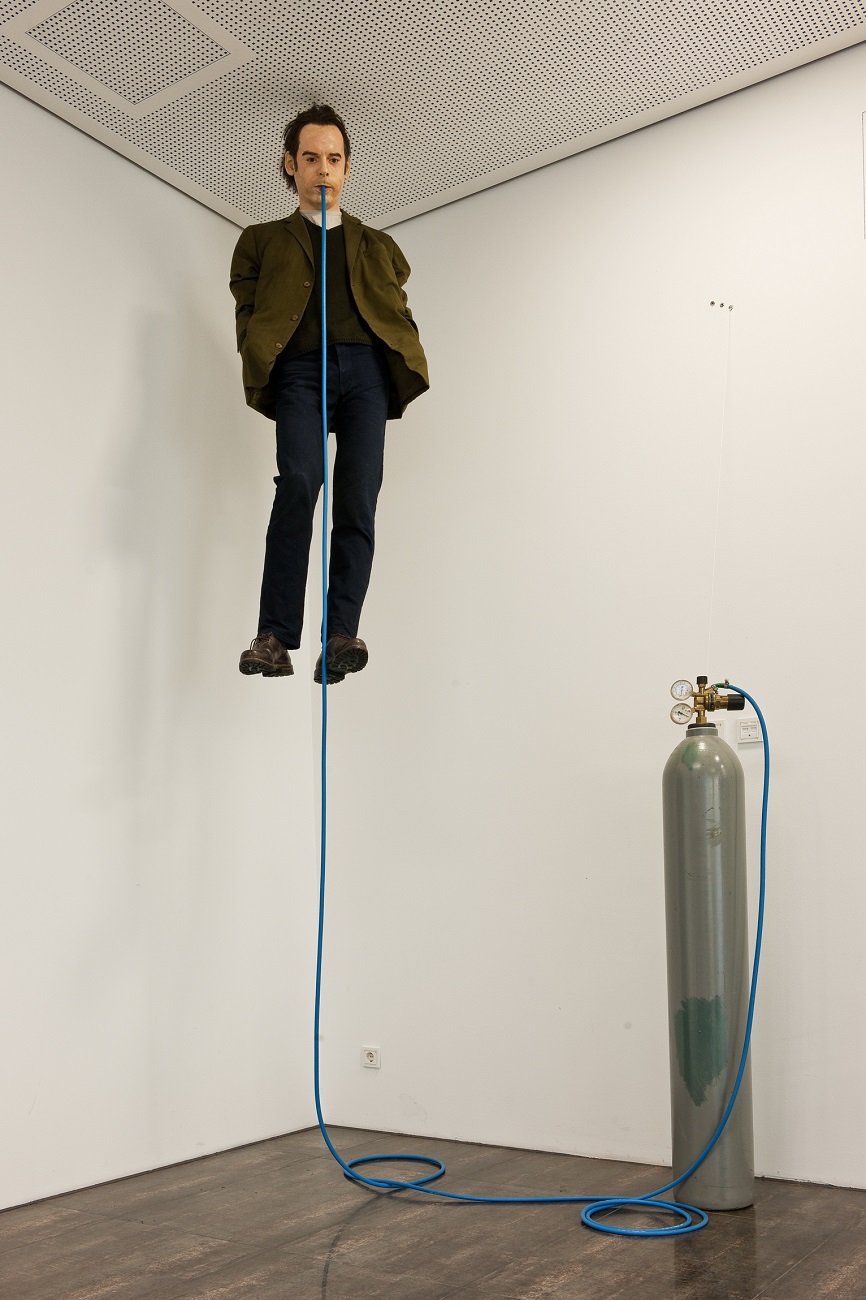
WERNER REITERER
Вернер Рейтерер
The Beginnings of Space Travel
Should art make us laugh? Styrian artist Werner Reiterer certainly challenges us to ponder on the sense and nonsenses of our world, but the noir humour and irreverent handling of reality in his approach mean that our first reaction is to laugh out loud. What we make of it afterwards is the long finish, as it were.
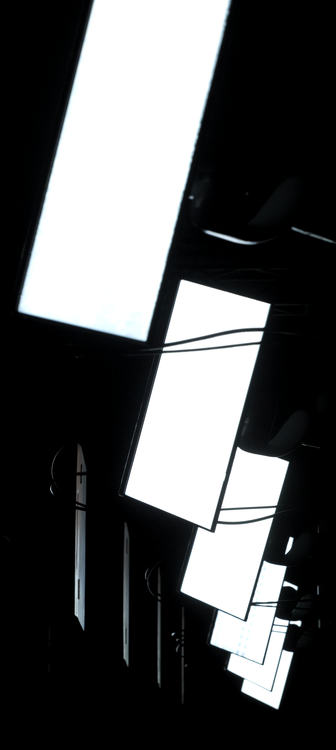
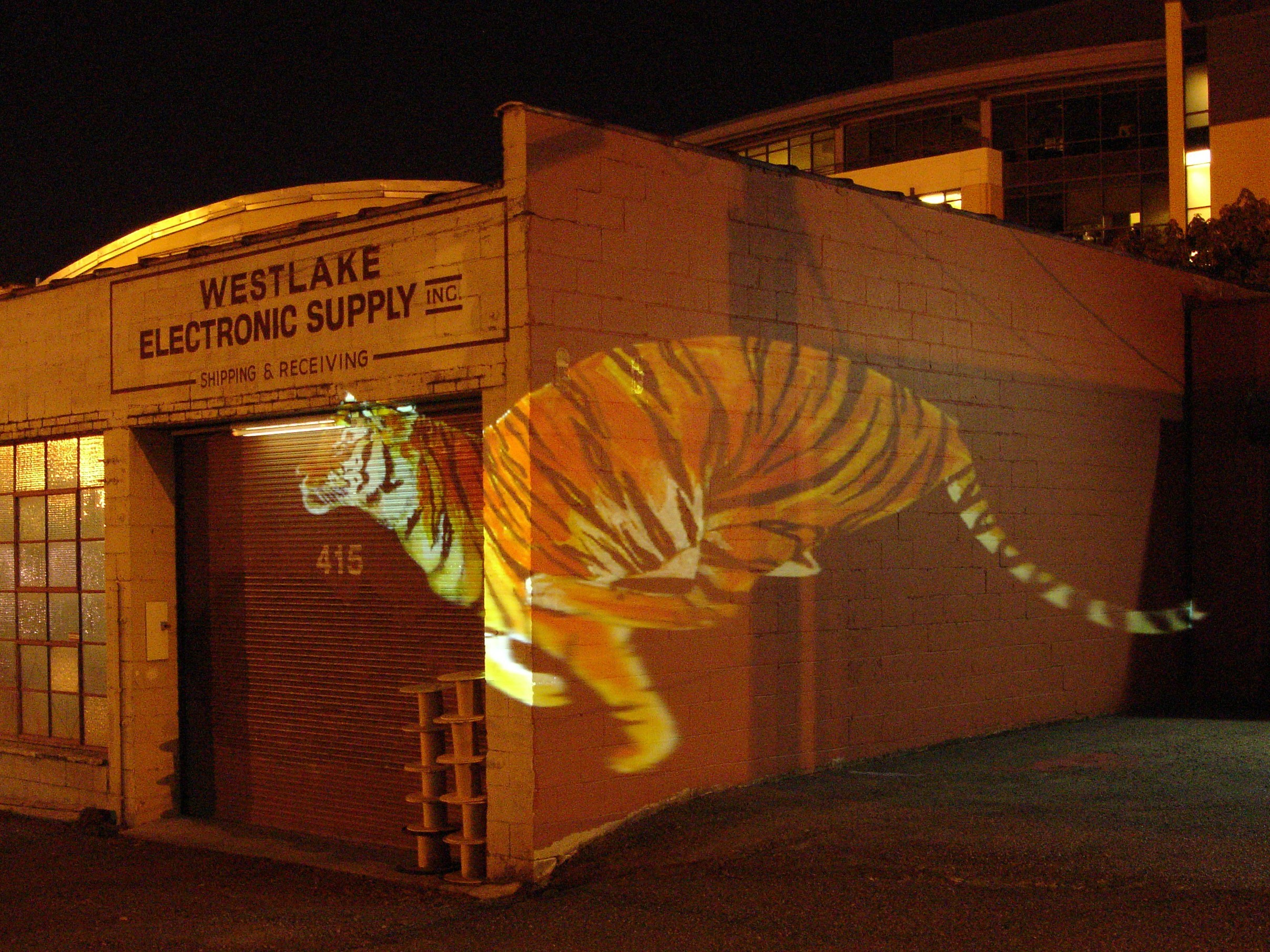
KAROLINA SOBECKA
カロリナ・ソアベッカ
Каролина Собечка
Wildlife
FILE FESTIVAL
At night a projection from a moving car is shone on the buildings. The car projects a video of a tiger whose movements are programmed to correspond to the speed of the car: as the car moves, the tiger runs along it speeding up and slowing down with the car, as the car stops, the tiger stops also. The framerate of the movie corresponds to the speed of the wheel rotation, picked up by a sensor. The viewers are elevated from the everyday reality through this element of fantasy into a world with more dimensions, possibilities and perhaps beauty.
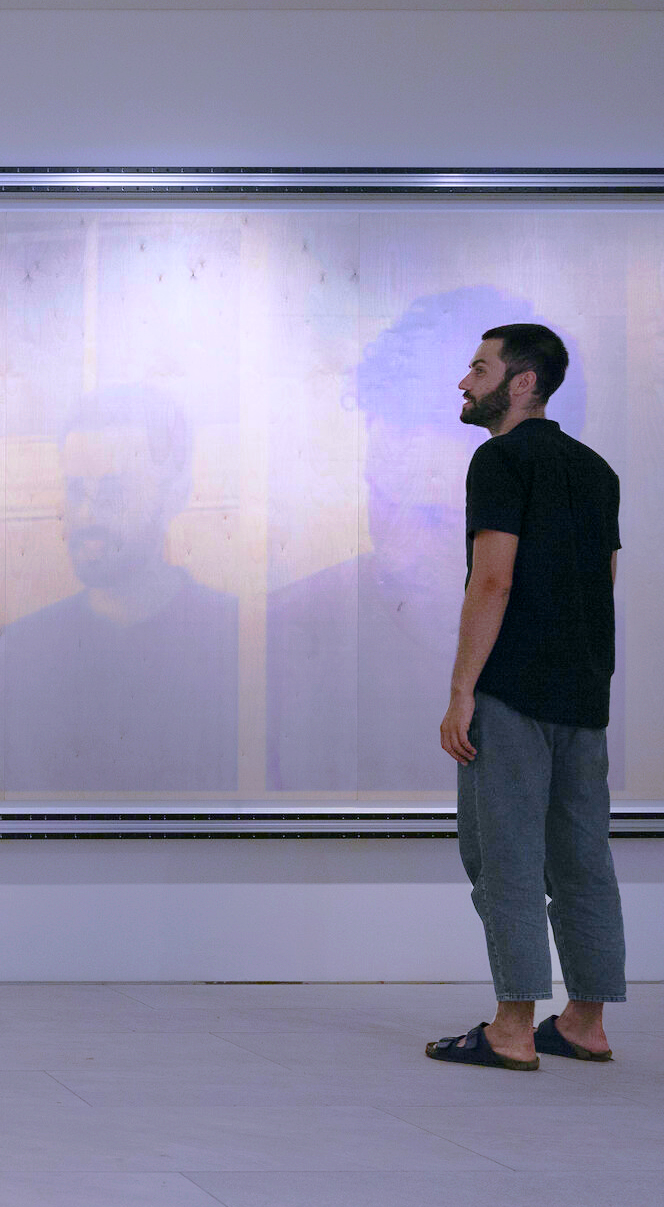
Random International
Presence and Erasure
Presence and Erasure is a portrait machine that explores the reality of automated facial recognition and how people relate to their self-image, instinctively and emotionally. Within a given spatial domain, the artwork constantly scans for faces in the vicinity and photographs them. When the artwork’s algorithm detects a certain quality within a photograph, this image is temporarily printed at large scale by exposing a photochromic surface to light impulses. Each automated portrait remains for little more than a minute, before gradually dissolving into blankness. RANDOM INTERNATIONAL began to combine transient mark-making with automated portraiture early on in their practice, in 2008. Presence and Erasure marks the latest development in this body of work and assumes a minimal, industrial aesthetic that references their earliest studies on this theme. The physical impact of facial recognition and machine vision is emphasised by the exposure of the printing process itself, contrasted against the aesthetic of the high resolution portraits generated. RANDOM INTERNATIONAL intend this as a counter to the perception of surveillance footage as always being low quality, aiming to create a deeper reflection on the nature of surveillance today as well as the resounding cognitive and emotional dissonances.

UJOO LIMHEEYOUNG
Machine Tree
Machine with Tree is a kinetic sculpture combining dead trees with metal machinery. It is designed to use the object’s center of gravity to achieve a movement where the tree appears to float in midair. In Machine with Tree, a dead tree is placed at the end of a long, sharp rod on the machine. The tree slowly moves back and forth with the machine’s movements, as though floating in midair. Through its creation of artificial, bizarre movements controlled by machinery, it illustrates a melancholy contemplation of the strange and contradictory things woven together by our reality.
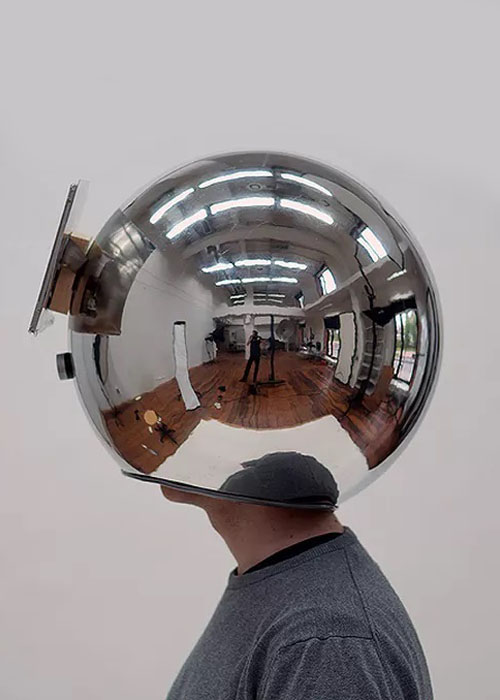
LORENZ POTTHAST
The Decelerator Helmet
The technique of the Decelerator extends the awareness of time and transforms the concept of present in a constructed, artificial state. On a different Level the helmet dramatically visualizes how slowing down under all circumstances causes a loss of actuality and as idea is inconsistent with it´s Environment. Technical enhancement as a tool to give us control about our perception, asks the question how far this influence can go, before we are all lost in how we want to see reality. The Decelerator unintentionally explores how aspects of this shift to a personalized perception could change our view of the world.

Meiro Koizumi
Prometheus gebonden
In de Griekse mythologie stal Prometheus vuur (technologie) van Zeus en gaf het aan mensen, en hiervoor werd hij gekruisigd op een bergtop en moest hij de eeuwige pijn als straf ondergaan. Sinds het begin van onze beschaving is technologie de bron van welvaart en ontwikkeling geweest. Maar het is ook de oorzaak geweest van grote tragedies zoals kernongevallen met oorlogszand. Met de Griekse tragedie van Aeschylus “Prometheus Bound” als uitgangspunt, creëerde Koizumi VR-theater (Virtual Reality) dat zich bezighoudt met deze eeuwenoude spanning tussen menselijkheid en technologie, door samenwerking met een persoon die wanhopig verlangt naar de technologische vooruitgang – een persoon die lijdt aan ALS (Amyotrofische Laterale Sclerose – de dodelijke neurologische ziekte die een persoon verlamd maakt). Door de dialogen met de man over zijn persoonlijke leven en zijn visies op de toekomst, creëerden ze een sci-fi visie waarin verleden en toekomst, zelf en anderen, mensen en machines allemaal worden samengevoegd tot één opeenvolging van abstracte VR-theatrale ervaring.

INES ALPHA
3D-make-up
Ines alpha is een 3D-artiest gevestigd in Parijs. Ze houdt ervan om betoverde en fantastische versies van de werkelijkheid te creëren. Ze begon te ervaren met 3D terwijl ze werkte als art director in reclame, gespecialiseerd in schoonheid en luxe. Haar belangrijkste oeuvre bestaat uit de serie “3D-make-up”, waarin ze de grenzen van make-up en schoonheid verlegt met behulp van 3D-software en augmented reality. Ze probeert te fantaseren hoe volledige esthetische vrijheid van uiterlijk eruit zou zien. Haar doel is om een leuke en creatieve benadering van make-up en zelfexpressie aan te moedigen.

Benedetto Bufalino
LABY-FOOT
As part of the 1 + 1 biennial, organised jointly by the Casino Luxembourg and the Fonds Kirchberg, the artist Benedetto Bufalino (born in 1982 in Décines; lives and works in Paris) was invited to submit a work for the plant labyrinth of the Kirchberg Central Park. The artist’s approach consists of investing urban space, playing with the architecture of given places and offering, with his funny or poetic installations, an offbeat reinterpretation of reality.
.
L’installation Laby-Foot de l’artiste Benedetto Bufalino se trouve à proximité du Centre National Sportif et Culturel d’Coque à Luxembourg-Kirchberg. Comme son nom l’indique, Laby-Foot est un terrain de football réinventé pour le labyrinthe végétal du parc central du Kirchberg. Ses formes et ses matériaux insolites permettent au public de l’explorer, de participer à des matchs de football et d’en repenser les règles.

REMTY ELENGA
ALL THE SCREENS IN MY HOUSE
Her nearby environment and the observations she makes in it form the starting point for Remty Elenga (Los Angeles, 1987) in creating new work. In doing this she likes to explore how we give meaning to various layers of reality, looking for contradictions in time and place, the visible and invisible, between what is real and what isn`t.
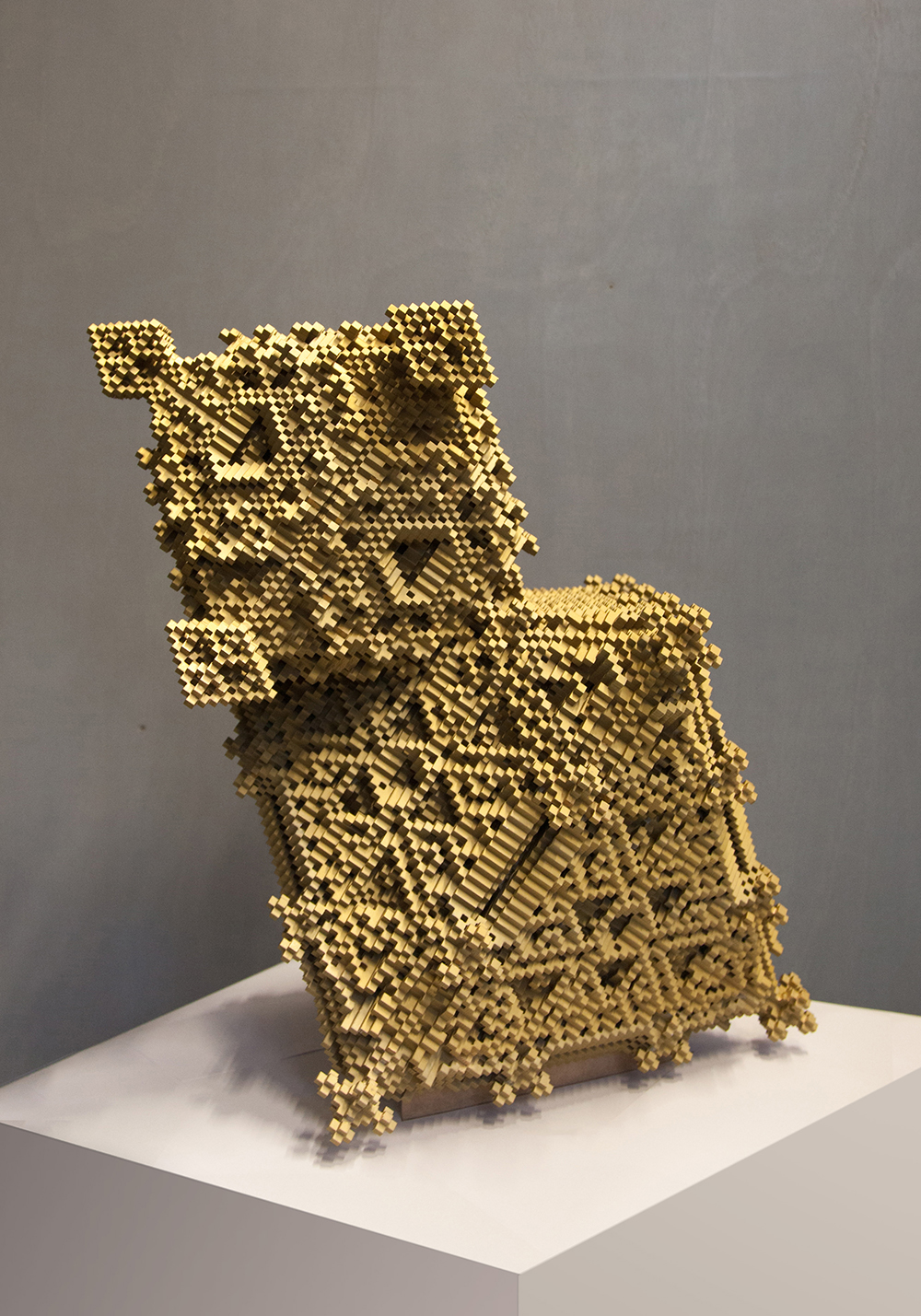
Troika
AVA
Ava’ is Troika’s first sculptural manifestation of their exploration of algorithms. ‘Ava’ is the physical result of emergence and self organisation brought about by ‘growing’ a sculpture through the use of a computer algorithm that imitates the emergence of life by which complexity arises from the simplest of things. As such the sculpture probes at the nature of becoming, existence and our strive to understand and replicate the complexities of life.In a landscape where our personal data is a raw material, and where we, humans, have become subordinate spectators of algorithms and a computerised infrastructure, we ask the question how much or little are we capable of influencing our surrounding reality, how much is predetermined, how much is down to chance.
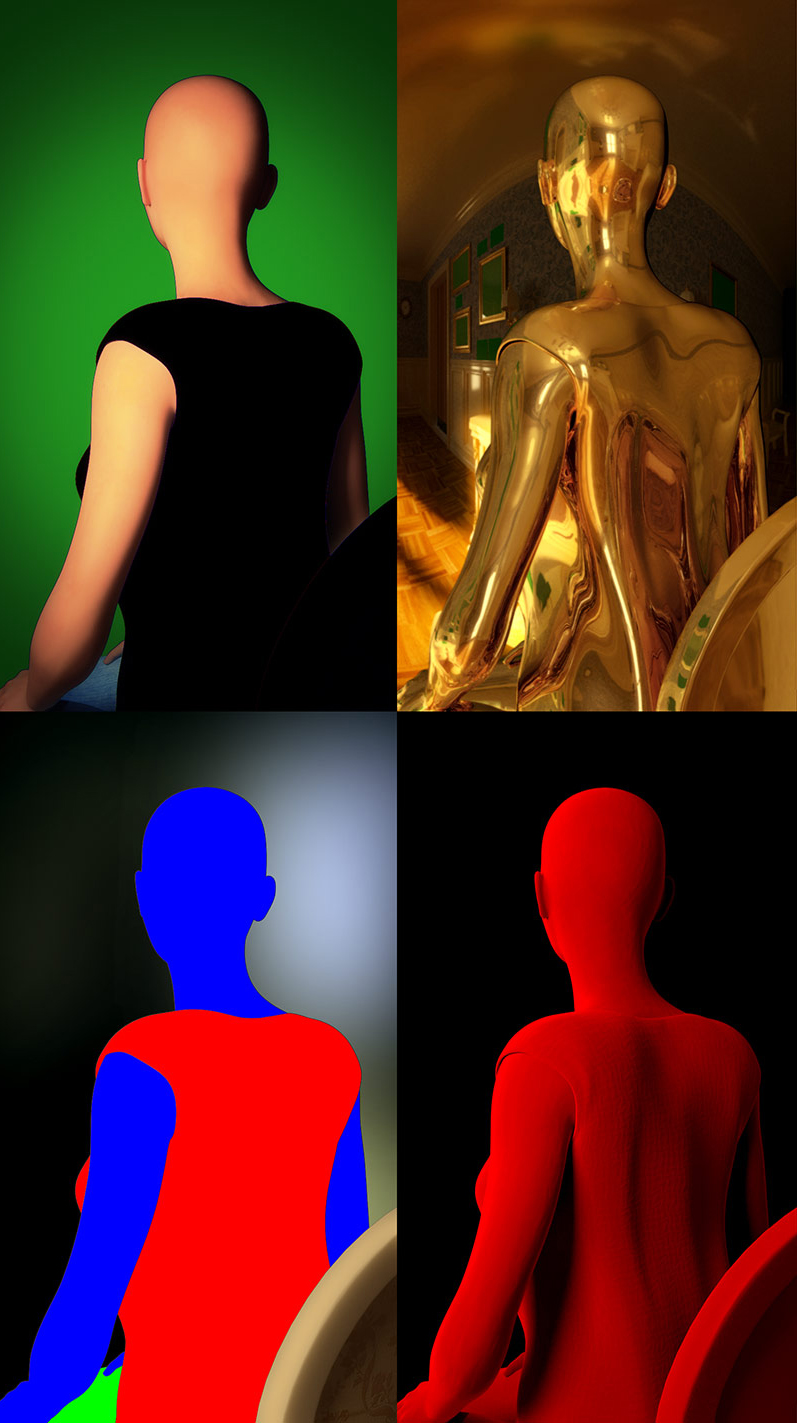
Alan Warburton
Spherical Harmonics
Spherical Harmonics is about the strange power of the CGI image. It’s a fantasy under construction, full of digitally created memories, counterfeit physics and controlled accidents. A place where reality fails because it’s too perfect. Spherical Harmonics sits stylistically at a halfway point between the glossy product displays of Oxford Street and the workhouse construction of Soho’s post production scene.
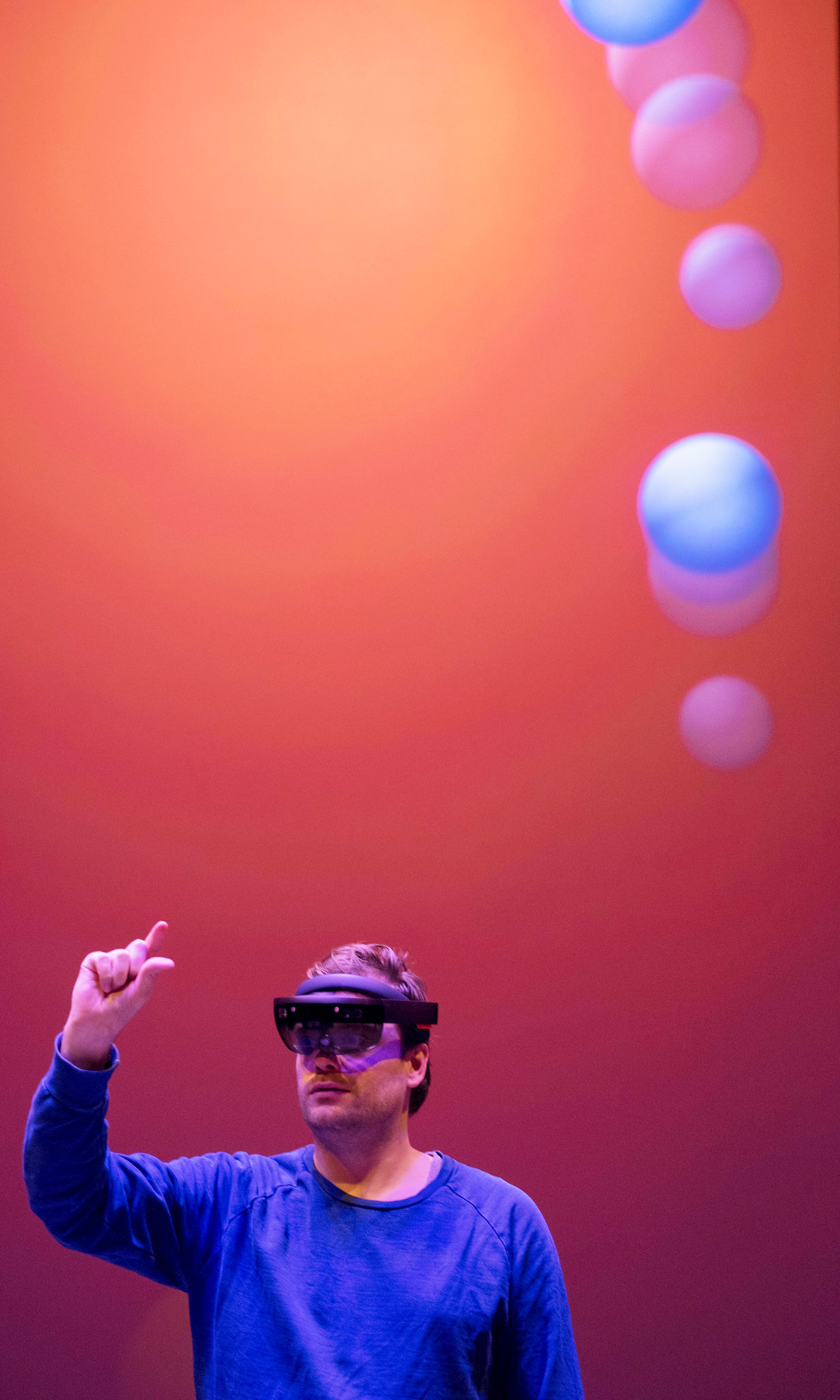
Brian Eno & Peter Chilvers
Bloom
Requiring no musical or technical ability, the egalitarian and user-friendly Bloom app enabled anyone of any age to create music, simply by touching the screen. Part instrument, part composition and part artwork, Bloom’s innovative controls allowed users to create elaborate patterns and unique melodies by simply tapping the screen. A generative music player took over when Bloom was left idle, creating an infinite selection of compositions and their accompanying visualizations. This version uses mixed reality with HoloLens.

INES ALPHA
antivirus mask and 3d makeups
“She tries to fantasize what complete aesthetic freedom of one’s appearance would look like. Her goal is to encourage a fun and creative approach to make up and self expression. By completely thrashing all preconceptions of what make-up is and how it’s used, Ines collaborates with various artists, musicians and models to produce her own fantastical versions of reality“. Teo Sandigliano

Gustav Deutsch
Shirley
Visions of reality
FILE FESTIVAL
Shirley is a woman in America in the 1930s, ‘40s, ‘50s, and early ‘60s. A woman who would like to influence the course of history with her professional and socio-political involvement. A woman who does not accept the reality of the Depression years, WWII, the McCarthy era, race conflicts and civil rights campaigns as given but rather as generated and adjustable.
Edward Hopper movie

